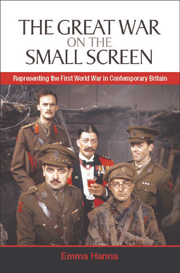Book contents
- Frontmatter
- Contents
- Acknowledgements
- List of abbreviations
- List of illustrations
- Introduction
- 1 An Unhealed Wound: Britain and the First World War
- 2 A Monumental Monument: The Great War (BBC, 1964)
- 3 Survivors: Veterans and the Nature of Personal Testimony
- 4 Heroes and Villains
- 5 Drama, Comedy and Drama Documentary
- 6 Over the Top: Reality Experiential Television
- 7 The Fear of Forgetting
- Filmography
- Bibliography
- Index
6 - Over the Top: Reality Experiential Television
Published online by Cambridge University Press: 05 August 2013
- Frontmatter
- Contents
- Acknowledgements
- List of abbreviations
- List of illustrations
- Introduction
- 1 An Unhealed Wound: Britain and the First World War
- 2 A Monumental Monument: The Great War (BBC, 1964)
- 3 Survivors: Veterans and the Nature of Personal Testimony
- 4 Heroes and Villains
- 5 Drama, Comedy and Drama Documentary
- 6 Over the Top: Reality Experiential Television
- 7 The Fear of Forgetting
- Filmography
- Bibliography
- Index
Summary
Programmes broadcast during and after the eightieth anniversaries formed the most public interface where new televisual representations of the conflict collided with the war's history and memory. During the eightieth anniversary commemorations of wartime events such as the Battle of the Somme in 1916 and the signing of the armistice in 1918, a number of single-episode and short-series programmes marked a change of direction which involved looking at more specific historical elements of the First World War. Haig: The Unknown Soldier (BBC, 1996), The Crucified Soldier (Channel 4, 2002) and Shot at Dawn (Carlton, 1998) have already been discussed in Chapter 4. One programme, however, pushed the boundaries of what had been done by previous documentaries about the First World War and stimulated a controversy all of its own.
The Trench (BBC, 2002)
In September 1999, novelist William Boyd made his directorial debut with The Trench, a film set in the front line of the trenches on the Somme in 1916, in what the film's publicity described as ‘a place 8 ft wide, 600 miles long, man-made and God-forsaken’. The film had a lukewarm reception and lacked the most basic factual elements, despite the efforts of the Association of Military Remembrance, the ‘Khaki Chums’, to train the actors in their permanent ‘home’ trench on an Essex farm to behave more like the soldiers of 1916.
- Type
- Chapter
- Information
- The Great War on the Small ScreenRepresenting the First World War in Contemporary Britain, pp. 143 - 162Publisher: Edinburgh University PressPrint publication year: 2009



